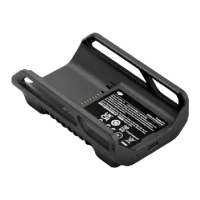DJI Dock 2/Matrice 3D Series Unmanned Aircraft Flight Manual
©
2024 DJI All Rights Reserved.
57
Normal Procedures
Airspace Environment
The dock shall be installed at an appropriate site by a DJI-authorized service provider. Make
sure that all ight routes around the installation site are carried out in an open area.
Operating Environment
• DO NOT operate the aircraft in severe weather conditions, including wind speeds exceeding
12 m/s
[1]
, snow, rain heavier than 2 mm/hour, and fog.
• Avoid obstacles, crowds, trees, and bodies of water (recommended height is at least 3 m
above water).
• The maximum takeoff altitude is 4000 m. The performance of the aircraft and its battery
is limited when flying at high altitudes. Fly with caution. When flying at a high altitude, a
minimum vertical braking distance of 20 m and a minimum horizontal braking distance
of 50 m are required in order to ensure ight safety.
• DO NOT use the aircraft or the dock in an environment at risk of a re or explosion.
• Only operate the dock and the aircraft for applications in the operating temperature
range. The operating temperature of the dock is -25° to 45° C (-13° to 113° F). The
operating temperature of the aircraft is -20° to 45° C (-4° to 113° F).
[2]
In low-temperature
environments, it is necessary to check whether the dock cover and the aircraft is covered
with snow and ice, and whether the propellers are frozen using the livestream of the dock
camera. DO NOT y in snow, or when the temperature is -5° to 5° C (23° to 41° F) and the
humidity is higher than 85%. Otherwise, the propellers may become frozen during flight,
consequently aecting ight safety.
• Make sure to set an alternate landing site before ight. The aircraft will y to the alternate
landing site when the dock is not suitable for landing. Follow the instructions in the DJI Pilot
2 app to set an alternate landing site when conguring the dock. An obvious sign should be
set up near the alternate landing site. Make sure that an area within a one-meter radius of
the alternate landing site is clear of obstacles.
[1] The aircraft can withstand a wind speed of up to 8 m/s during takeo and landing.
[2] When the temperature is below -20° C (-4° F), the aircraft cannot perform ight tasks.
Flight Restrictions and Unlocking
Geospatial Environment Online (GEO) System
The DJI Geospatial Environment Online (GEO) System is a global information system that
provides real-time information on ight safety and restriction updates, and prevents UAVs from
ying in restricted airspace. Under exceptional circumstances, restricted areas can be unlocked
to allow ight. Prior to that, the user must submit an unlocking request based on the current
restriction level in the intended ight area. The GEO System may not fully comply with local laws
and regulations. Users shall be responsible for their own ight safety and must consult with the
local authorities on the relevant legal and regulatory requirements before requesting to unlock
a ight in a restricted area.

